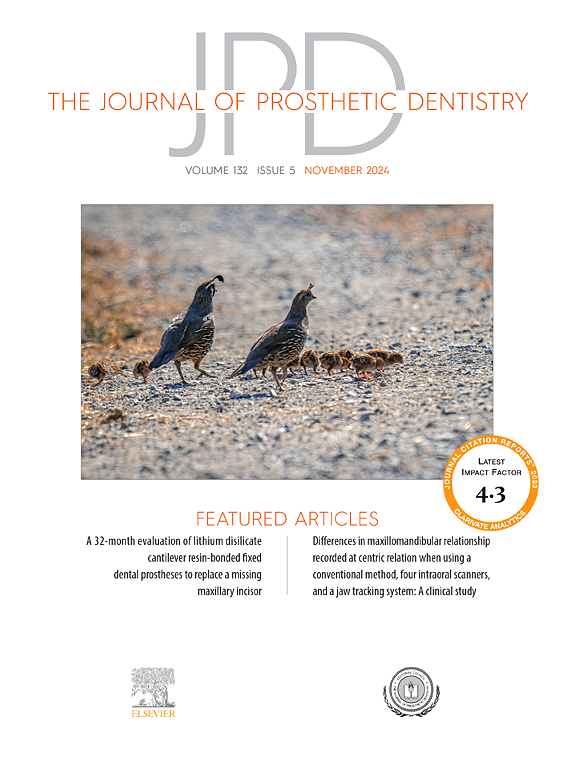由先进与传统二硅酸锂陶瓷制成的椅边层压板单板垂直边缘间隙和内部配合的比较:一项体外研究。
IF 4.8
2区 医学
Q1 DENTISTRY, ORAL SURGERY & MEDICINE
引用次数: 0
摘要
问题说明:每当提倡层压板贴面时,通常选择传统的二硅酸锂材料。先进的二硅酸锂(CEREC Tessera)已经推出,被认为是传统二硅酸锂在减少椅边时间方面的有利替代品。然而,它作为层压单板制造材料的可靠性还没有得到充分的评估。目的:本体外研究的目的是评估由先进的二硅酸锂陶瓷与传统的二硅酸锂陶瓷制成的层压板贴面的垂直边缘间隙和内部配合。材料与方法:制作上颌中切牙层压贴面22枚,分为2组;E组(e.max CAD):由传统的二硅酸锂制成;T组(Tessera):由先进的二硅酸锂制成。按照推荐的参数制作一颗排印型上颌右中切牙,然后扫描、设计和铣削层压板贴面。利用数码显微镜,分别采用直接观察法和硅胶复刻法,对牙型牙上层压板的垂直边缘间隙和内部配合进行定量测量。采用Student t检验对结果进行统计学分析(α= 0.05)。结果:两组患者的平均值差异有统计学意义。T组的平均垂直边缘间隙(40.5µm)低于E组(52.6µm)。结论:先进的二硅酸锂贴片比传统的二硅酸锂贴片具有更好的垂直边缘间隙和更低的内部配合度。本文章由计算机程序翻译,如有差异,请以英文原文为准。
Comparison of vertical marginal gap and internal fit of chairside laminate veneers fabricated from advanced versus conventional lithium disilicate ceramics: An in vitro study
Statement of problem
Conventional lithium disilicate material is frequently the material of choice whenever laminate veneers are advocated. Advanced lithium disilicate (CEREC Tessera) has been introduced and is thought to be a favorable alternative to conventional lithium disilicates in terms of reduced chairside time. However, its reliability as a material for laminate veneer fabrication has not been adequately assessed.
Purpose
The purpose of this in vitro study was to assess the vertical marginal gap and internal fit of laminate veneers fabricated from the advanced lithium disilicate ceramic versus the conventional lithium disilicate ceramic.
Material and methods
A total of 22 laminate veneers were fabricated for a maxillary central incisor and divided into 2 groups; Group E (e.max CAD): fabricated from conventional lithium disilicate and Group T (Tessera):fabricated from advanced lithium disilicate. A typodont maxillary right central incisor was prepared by following the recommended parameters, and the laminate veneers were then scanned, designed, and milled. Quantitative measurements of the vertical marginal gap and internal fit of the laminate veneers on the typodont tooth were made by direct viewing and the silicone replica approach, respectively, using a digital microscope. The Student t test was performed for statistical analysis of the results (α=.05).
Results
The mean values of both groups varied significantly. Group T had a lower mean vertical marginal gap (40.5 µm) than group E (52.6 µm) (P<.05). In terms of internal fit, group T had a higher value (191.5 µm) than group E (142.4 µm) (P<.05).
Conclusions
Advanced lithium disilicate laminate veneers revealed better vertical marginal gap and lower internal fit than conventional lithium disilicate laminate veneers.
求助全文
通过发布文献求助,成功后即可免费获取论文全文。
去求助
来源期刊

Journal of Prosthetic Dentistry
医学-牙科与口腔外科
CiteScore
7.00
自引率
13.00%
发文量
599
审稿时长
69 days
期刊介绍:
The Journal of Prosthetic Dentistry is the leading professional journal devoted exclusively to prosthetic and restorative dentistry. The Journal is the official publication for 24 leading U.S. international prosthodontic organizations. The monthly publication features timely, original peer-reviewed articles on the newest techniques, dental materials, and research findings. The Journal serves prosthodontists and dentists in advanced practice, and features color photos that illustrate many step-by-step procedures. The Journal of Prosthetic Dentistry is included in Index Medicus and CINAHL.
 求助内容:
求助内容: 应助结果提醒方式:
应助结果提醒方式:


